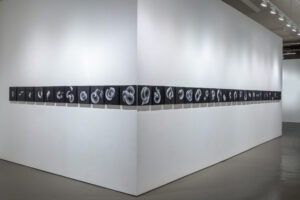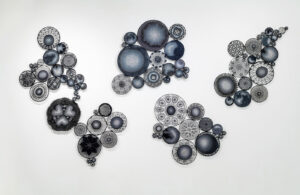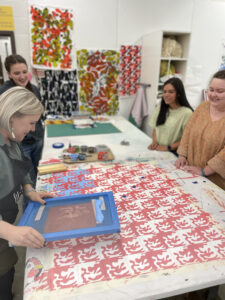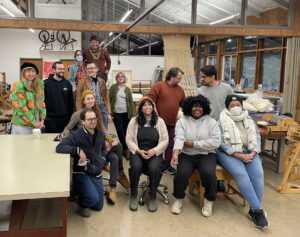Rena Wood interviewed by Bryana Bibbs
February 17, 2023
I had the pleasure of meeting and interviewing Rena Wood during Arrowmont’s Winter Pentaculum, and learning about Rena’s practice as an artist and arts educator. What fascinates me most about Rena’s work is the subject of memory and the use of slow and labor-intensive textile processes.

Rena Wood, Dissemination, 2020-Present. Coiled Wire and hand-dyed vintage textiles, dimensions vary. Photo: E.G. Schempf.
Rena, please tell us a bit about yourself and where you are currently based.
I am a fiber artist and educator currently residing in Middle Tennessee. I am the program head of Fibers at Tennessee Tech University’s Appalachian Center for Craft. I was raised in St. Louis and completed my BFA in Fibers at the Kansas City Art Institute. After graduation, I lived in St. Louis for a while and was a resident at the Craft Alliance for a year. Later on, I moved to Richmond, VA to pursue my MFA in Craft/Materials Studies at Virginia Commonwealth University. I have traveled throughout the country for residencies and teaching opportunities, before finally settling at Tennessee Tech.

Rena Wood, 36 Lines, 2019. Hand Embroidered silk, 12 x 12 inches each. Photo: E.G. Schempf.
How did you become interested in fiber?
I cannot pinpoint a specific moment when I realized I was most interested in the fiber medium. From a young age, I was always busy making crafts and enjoyed experimenting with new materials. My parents, who are both makers, supported my creative inclinations. The home I grew up in held my father’s painting studio and my mother’s sewing room, both a source of material inspiration from a young age. As I grew older, I began to learn how to sew. In high school, I made a quilt out of my clothing; plaid school uniforms and old blue jeans. I used it in my portfolio to help me get into school at the Kansas City Art Institute. After completing my foundations year, I decided to major in Fiber Arts because it offered the most diverse possibilities for making art, and that is where I discovered my passion for textiles. I fell in love with learning fiber processes and techniques, especially hand stitching, and never looked back!
I love that your work explores memory through the use of stitching. Could you talk more about this exploration of memory and how you use scale and color for this body of work?
I believe that textiles inherently hold memories, and like many fiber artists, I find meaning in the memories that textiles hold. I am fascinated by the way memories change and reshape over time, as well as how they make up such a large part of who we are. I enjoy the idea that as I stitch, I am embedding my thoughts into a piece of fabric. I am interested in creating large-scale artwork and installations with labor intensive processes like hand stitching to bring in the element of time and draw attention to the ‘work’ of repetitive processes. In 36 Lines each piece captures a thought forming or floating away, depending on how you view it. The twisted line in my work serves as a visual representation of an imagined microscopic appearance of amyloid plaques or neurofibrillary tangles found in the brain of Alzheimer’s disease patients. When I use vintage textiles, I imagine that I am working in response to or in collaboration with the original maker. For example, when I embroider on table linens, I begin by outlining the existing handwork on the fabric, and the resulting pattern is formed in response to the negative space on the cloth. I dye vintage textiles black to erase some of their history; they are in the shadow of the past and it projects a somber or quiet tone. I also use black and white in my work because aesthetically, I am drawn to the formal elements of line and contrast, and conceptually to the fact that the color black contains all colors and holds a lot of visual weight.

Rena Wood, Cellular Memory, 2018-present.Hand Embroidered hand-dyed vintage textiles, dimensions vary. Photo: E.G. Schempf.

Rena Wood, Cellular Memory (detail), 2018-present.Hand Embroidered hand-dyed vintage textiles, dimensions vary. Photo: E.G. Schempf.
Tell us about your journey as an educator.
I am lucky to say that I am doing the job that I always wanted to have! My father was a professor of art for 47 years and as a child I always wanted to follow in his footsteps. When I finished undergrad, it seemed like an impossible goal, but I began teaching short workshops and had the opportunity to teach children and adults different fiber art processes while I was a resident artist at the Craft Alliance in St. Louis. I quickly realized how rewarding it was to help others develop a passion for fiber art and so I began to pursue a career in education more seriously. I chose to attend a graduate program that provided me with teaching experience while in school. I learned a lot about teaching from my mentor, Susan Iverson, at VCU. When I got out of school, I took every opportunity I could to gain experience teaching in various settings. As a resident at Arrowmont School of Arts and Crafts, I taught community classes for adults and outreach classes for children…Currently, I am the head of the Fibers area in the School of Art, Craft and Design at Tennessee Tech University where I teach all levels of Fiber art courses. Recently, I worked with a faculty in the Chemistry department at Tech to teach an Honors Colloquium course, The Chemistry of Fibers: Structures and Dyes.

Rena Wood demonstrating in the Surface Studio at Tennessee Tech University’s Appalachian Center for Craft, 2023.
What is it like for you to hold space for other creatives that are interested in expanding their arts practice or just now beginning one?
I am grateful for the individuals who encouraged me when I was starting out in my career, and I try to be a positive role model for others in the same way. As an educator, one of my main goals is to help students understand that anything is possible. I aim to create a classroom environment that is supportive and where students feel comfortable taking risks without fear of failure. In my experience, the fiber art community is welcoming, supportive, and inclusive, and I try to cultivate that same atmosphere in my classroom. Additionally, I want to help connect people, including my students and friends, to create a vast network of fiber artists. I am fortunate to have the opportunity to serve a 3-year term as the coordinator for Arrowmont’s winter Pentaculum, where I bring artists together to work in the studio at Arrowmont for 5 days. During the past session, I watched as the 13 invited artists became friends, shared ideas, and inspired each other despite their diverse ages, locations, and backgrounds. We share a common passion for fiber art and in a short amount of time developed meaningful (and lasting) connections with each other. It’s a rare opportunity to work in that type of atmosphere and I feel honored that I get to put together this event for another year.

Fibers Studio Participants at Arrowmont’s 2023 Winter Pentaculum.
Do you find that there is a connection between your art practice and your role as an educator?
I am constantly inspired by my students. Teaching fiber art full-time motivates me to spend time researching new techniques, practice different fiber processes, and read books and articles about textiles. I get to share all of this with my students and it is hard not to let it begin to filter into my own work. I hear myself advising my students to experiment, spend more time, take chances, and not be afraid of failure. I think it’s important to show them that I am also trying to take that advice in my own studio.

